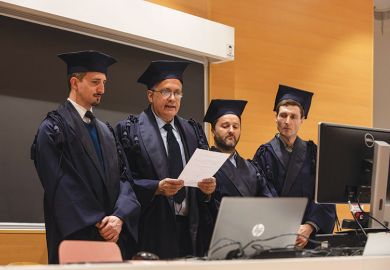The global academic discussion about transitioning to online teaching in response to Covid-19 has already precipitated a blizzard of advice in the educational press on the technology and practice of online pedagogy. However, less attention has been given to how exactly to put everything together at an administrative level, taking all aspects of the student experience into account.
Each institution’s circumstances are slightly different, but there are some wider lessons in the contingency planning that Hong Kong universities have had to undertake in response to both the coronavirus and last year’s anti-government protests. These twin disruptions, one coming close on the heels of the other, have resulted in face-to-face teaching being cut to just one-third of the original schedule.
The first thing that comes into a student’s mind when teaching is moved online is how their attendance will be monitored, as universities often have minimum requirements to sit exams. Online login records cannot accurately reflect a student’s presence because leaving a virtual lecture soon after logging on is a lot easier than leaving a physical one. A credible alternative is to use engagement as a proxy for attendance, with key tasks spaced out during the online teaching semester.
Another question likely to be raised by both staff and students is how to equate online teaching hours with their physical equivalent. As several platforms are often used in combination for both synchronous and asynchronous online delivery, a total contact hours approach can be used. Typically, teachers at the Open University of Hong Kong plan a combination of synchronous lectures, demonstrations and discussions, plus small group tutorials, which follow up on previously distributed PowerPoints with incorporated voiceovers for advanced reading. We add all these components together to derive a minimum requirement for online teaching of 120 per cent of original contact hours: a figure that provides assurance to students that they are not being short-changed.
A common concern to everyone is teaching quality. Discussion-rich interactions between students and teachers hold an online class together, and maintaining teacher-learner and learner-learner relationships is what distinguishes this kind of online teaching from independent learning via Moocs. Some of our online classes have reported enhanced participation by students who were less active in face-to-face sessions. This was a pleasant surprise, since we know too well that Chinese learners are often seen to be silent and passive in regular classrooms.
From students’ perspective, what matters most is assessment: the format it will take and what they need to do to pass it. Projects, special assignments or open book exams are valid online replacements for standard exams as long as they can assess the same learning outcomes. However, to allay students’ anxiety, clear instructions and grading criteria should be announced as early as practicable to ensure that there are no surprises. Students should also be permitted to opt for a simple pass/fail marking scheme to relieve the pressure; this also has the virtue of avoiding grade disputes.
Academic help sessions should be made available online or in small face-to-face groups (while observing social distancing). Additionally, teachers need to know how to deliver pastoral care and guidance at a distance. Messaging apps are the obvious tools for communicating with individuals or a group of students, but instructors risk being overwhelmed if they don’t restrict contact to the equivalent of office hours. It may also make sense to prioritise graduating classes, which are more likely to need references and recommendation letters.
As for the teaching and learning that ordinarily take place beyond the campus, alternatives can normally be found with sufficient thought, although they aren’t necessarily ideal. For example, outdoor group activities combined with overnight camps, aimed at testing leadership, collaborative and problem-solving skills, can be replaced by scenario-based tasks and role plays, on which groups of students can be asked to work together online. Graduation exhibitions and public performances, which serve to meet essential graduation requirements, can instead be livestreamed to registered guests.
The damage inflicted on businesses by the coronavirus also has the potential to affect internship placements and work-integrated learning, which may ordinarily be a condition of graduation in some subjects. Deferment of such requirements or substituting them with voluntary work or industry-based projects can partially resolve the difficulty.
The student experience is about more than just academic matters, however, and most extracurricular activities have also been curtailed because of the coronavirus. This threatens potential trouble for students’ mental health, so a regular personal wellness regimen should accompany the online teaching throughout the period of self-isolation. In our experience, students have appreciated real-time broadcast sessions on yoga practice, mindful eating, breathing exercises and zentangle (structured drawing).
In anticipation of the possible retreat of the virus in warmer weather, it may also make sense to carry out advance planning for a summer school. This could go some way to compensate students for the lost semester and help them attain a sense of closure.
It falls on administrators to initiate such remedies, demonstrating resilience, leadership and skilful crisis management. Working alongside their teaching colleagues, they can help reclaim and rebuild the learning opportunities that have been lost.
Benjamin Tak Yuen Chan is dean of the Li Ka Shing School of Professional and Continuing Education at the Open University of Hong Kong. He is also honorary associate professor in education at the University of Hong Kong’s School of Professional and Continuing Education.
Register to continue
Why register?
- Registration is free and only takes a moment
- Once registered, you can read 3 articles a month
- Sign up for our newsletter
Subscribe
Or subscribe for unlimited access to:
- Unlimited access to news, views, insights & reviews
- Digital editions
- Digital access to THE’s university and college rankings analysis
Already registered or a current subscriber?






